Non-renewable resource
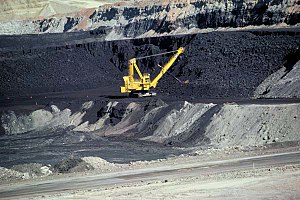
Anon-renewable resource(also called afinite resource) is anatural resourcethat cannot be readily replaced by natural means at a pace quick enough to keep up with consumption.[1]An example is carbon-based fossil fuels. The original organic matter, with the aid of heat and pressure, becomes a fuel such as oil or gas. Earthmineralsandmetalores,fossil fuels(coal,petroleum,natural gas) andgroundwaterin certainaquifersare all considered non-renewable resources, though individualelementsare always conserved (except innuclear reactions,nuclear decayoratmospheric escape).
Conversely, resources such astimber(whenharvested sustainably) and wind (used to power energy conversion systems) are consideredrenewable resources,largely because their localized replenishment can also occur within human lifespans.
Earth minerals and metal ores
[edit]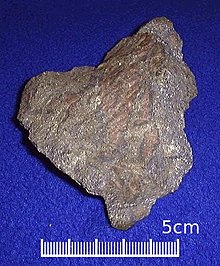
Earthminerals andmetalores are examples of non-renewable resources. The metals themselves are present in vast amounts in Earth'scrust,and their extraction by humans only occurs where they are concentrated bynatural geological processes(such as heat, pressure, organic activity, weathering and other processes) enough to become economically viable to extract. These processes generally take from tens of thousands to millions of years, throughplate tectonics,tectonic subsidenceandcrustal recycling.
The localized deposits of metal ores near the surface which can be extracted economically by humans are non-renewable in human time-frames. There are certainrare earth mineralsandelementsthat are more scarce and exhaustible than others. These are in high demand inmanufacturing,particularly for theelectronics industry.
Fossil fuels
[edit]Natural resources such ascoal,petroleum(crude oil) andnatural gastake thousands of years to form naturally and cannot be replaced as fast as they are being consumed. It is projected that fossil-based resources will eventually become too costly to harvest and humanity will need to shift its reliance torenewable energysuch as solar or wind power.
An alternative hypothesis is that carbon-based fuel is virtually inexhaustible in human terms, if one includes all sources of carbon-based energy such as methane hydrates on the sea floor, which are much greater than all other carbon-based fossil fuel resources combined.[2]These sources of carbon are also considered non-renewable, although their rate of formation/replenishment on the sea floor is not known. However, their extraction at economically viable costs and rates has yet to be determined.
At present, the main energy source used by humans is non-renewablefossil fuels.Since the dawn ofinternal combustion enginetechnologies in the 19th century, petroleum and other fossil fuels have remained in continual demand. As a result, conventionalinfrastructureandtransportsystems, which are fitted to combustion engines, remain predominant around the globe.
The modern-day fossil fuel economy is widely criticized for its lack of renewability, as well as being a contributor toclimate change.[3]
Nuclear fuels
[edit]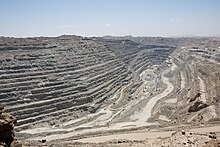
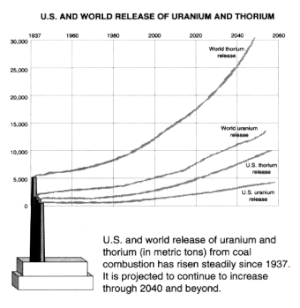
In 1987, theWorld Commission on Environment and Development(WCED) classified fission reactors that produce morefissilenuclear fuel than they consume (i.e.breeder reactors) among conventional renewable energy sources, such assolarandfalling water.[7]TheAmerican Petroleum Institutelikewise does not consider conventional nuclear fission as renewable, but rather thatbreeder reactornuclear power fuel is considered renewable and sustainable, noting that radioactive waste from usedspent fuelrods remains radioactive and so has to be very carefully stored for several hundred years.[8]With the careful monitoring of radioactive waste products also being required upon the use of other renewable energy sources, such asgeothermal energy.[9]
The use ofnuclear technologyrelying onfissionrequiresnaturally occurring radioactive materialas fuel.Uranium,the most common fission fuel, is present in the ground at relatively low concentrations andminedin 19 countries.[10]This mined uranium is used to fuel energy-generating nuclear reactors withfissionableuranium-235which generates heat that is ultimately used to powerturbinesto generate electricity.[11]
As of 2013 only a few kilograms (picture available) of uranium have been extracted from the ocean inpilot programsand it is also believed that the uranium extracted on an industrial scale from the seawater would constantly be replenished from uraniumleachedfrom the ocean floor, maintaining the seawater concentration at a stable level.[12]In 2014, with the advances made in the efficiency of seawater uranium extraction, a paper in the journal ofMarine Science & Engineeringsuggests that with, light water reactors as its target, the process would beeconomically competitive if implemented on a large scale.[13]
Nuclear power provides about 6% of the world's energy and 13–14% of the world's electricity.[14]Nuclear energy production is associated with potentially dangerousradioactive contaminationas it relies upon unstable elements. In particular, nuclear power facilities produce about 200,000 metric tons oflow and intermediate level waste(LILW) and 10,000 metric tons ofhigh level waste(HLW) (including spent fuel designated as waste) each year worldwide.[15]
Separate from the question of the sustainability of nuclear fuel use are concerns about the high-level radioactive waste the nuclear industry generates, which if not properly contained, ishighly hazardousto people and wildlife. The United Nations (UNSCEAR) estimated in 2008 that average annual human radiation exposure includes 0.01millisievert(mSv) from the legacy of past atmospheric nuclear testing plus theChernobyl disasterand the nuclear fuel cycle, along with 2.0 mSv from natural radioisotopes and 0.4 mSv fromcosmic rays;all exposuresvary by location.[16]Natural uraniumin some inefficient reactornuclear fuel cyclesbecomes part of thenuclear waste"once through"stream, and in a similar manner to the scenario were this uranium remained naturally in the ground, this uranium emits various forms of radiation in adecay chainthat has ahalf-lifeof about 4.5 billion years.[17]The storage of this unused uranium and the accompanying fission reaction products has raised public concerns aboutrisks of leaks and containment,however studies conducted on thenatural nuclear fission reactorin OkloGabon,have informed geologists on the proven processes that kept the waste from this 2 billion year old natural nuclear reactor.[18]
Land surface
[edit]Land surface can be considered both a renewable and non-renewable resource depending on the scope of comparison.Landcan be reused, but new land cannot be created on demand, making it a fixed resource with perfectlyinelastic supply[19][20]from an economic perspective.
Renewable resources
[edit]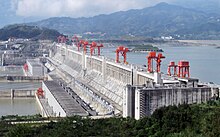
Natural resources,known as renewable resources, are replaced bynatural processes and forcespersistent in thenatural environment.There areintermittentand reoccurring renewables, andrecyclable materials,which are utilized during acycleacross a certain amount of time, and can be harnessed for any number of cycles.
The production of goods and services bymanufacturingproductsineconomic systemscreates manytypes of wasteduring production and after theconsumerhas made use of it. The material is then eitherincinerated,buried in alandfillorrecycledfor reuse. Recycling turns materials of value that would otherwise become waste into valuable resources again.
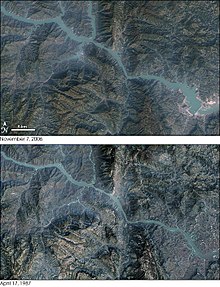
In the natural environmentwater,forests,plantsandanimalsare all renewable resources, as long as they are adequatelymonitored, protected and conserved.Sustainable agricultureis the cultivation of plant and animal materials in a manner that preserves plant and animalecosystemsand that can improvesoil healthandsoil fertilityover the long term. Theoverfishingof the oceans is one example of where an industry practice or method can threaten an ecosystem, endangerspeciesand possibly even determine whether or not afisheryis sustainable for use by humans. An unregulated industry practice or method can lead to a completeresource depletion.[23]
The renewable energy from thesun,wind,wave,biomassandgeothermalenergies are based on renewable resources. Renewable resources such as the movement ofwater(hydropower,tidal powerandwave power),windandradiant energyfrom geothermal heat (used forgeothermal power) and solar energy (used forsolar power) are practically infinite and cannot be depleted, unlike their non-renewable counterparts, which are likely to run out if not used sparingly.
The potential waveenergyon coastlines can provide 1/5 of world demand. Hydroelectric power can supply 1/3 of our total energy global needs. Geothermal energy can provide 1.5 more times the energy we need. There is enough wind to power all of humanity's needs 30 times over. Solar currently supplies only 0.1% of our world energy needs, but could power humanity's needs 4,000 times over, the entire global projected energy demand by 2050.[24][25]
Renewable energy andenergy efficiencyare no longer nichesectorsthat are promoted only by governments and environmentalists. The increasing levels of investment and capital from conventional financial actors suggest thatsustainable energyhas become mainstream and the future of energy production, as non-renewable resources decline. This is reinforced byclimate changeconcerns, nuclear dangers and accumulating radioactive waste,high oil prices,peak oiland increasing government support for renewable energy. These factors arecommercializing renewable energy,enlarging the market and increasing the adoption of new products to replace obsolete technology and the conversion of existing infrastructure to a renewable standard.[26]
Economic models
[edit]In economics, a non-renewable resource is defined asgoodswhose greater consumption today implies less consumption tomorrow.[27]David Ricardoin his early works analysed the pricing of exhaustible resources, and argued that the price of a mineral resource should increase over time. He argued that the spot price is always determined by the mine with the highest cost of extraction, and mine owners with lower extraction costs benefit from a differential rent. The first model is defined byHotelling's rule,which is a 1931 economic model of non-renewableresource managementbyHarold Hotelling.It shows that efficient exploitation of a nonrenewable and nonaugmentable resource would, under otherwise stable conditions, lead to adepletionof the resource. The rule states that this would lead to a net price or "Hotelling rent"for it that rises annually at a rate equal to therate of interest,reflecting the increasing scarcity of the resources.[28]TheHartwick's ruleprovides an important result about thesustainabilityof welfare in an economy that uses non-renewable resources.[29]
See also
[edit]References
[edit]- ^Earth systems and environmental sciences.[Place of publication not identified]: Elsevier. 2013.ISBN978-0-12-409548-9.OCLC846463785.
- ^"Methane hydrates".Worldoceanreview.com.Retrieved17 January2017.
- ^America's Climate Choices: Panel on Advancing the Science of Climate Change; National Research Council (2010).Advancing the Science of Climate Change.Washington, D.C.: The National Academies Press.doi:10.17226/12782.ISBN978-0-309-14588-6.
- ^Rössing(from infomine.com, status Friday 30 September 2005)
- ^U.S. Geological Survey(October 1997)."Radioactive Elements in Coal and Fly Ash: Abundance, Forms, and Environmental Significance"(PDF).U.S. Geological Survey Fact Sheet FS-163-97.
- ^"Coal Combustion – ORNL Review Vol. 26, No. 3&4, 1993".Archived fromthe originalon 5 February 2007.
- ^Brundtland, Gro Harlem (20 March 1987)."Chapter 7: Energy: Choices for Environment and Development".Our Common Future: Report of the World Commission on Environment and Development.Oslo.Retrieved27 March2013.
Today's primary sources of energy are mainly non-renewable: natural gas, oil, coal, peat, and conventional nuclear power. There are also renewable sources, including wood, plants, dung, falling water, geothermal sources, solar, tidal, wind, and wave energy, as well as human and animal muscle-power. Nuclear reactors that produce their own fuel ( "breeders" ) and eventually fusion reactors are also in this category
- ^American Petroleum Institute."Key Characteristics of Nonrenewable Resources".Retrieved21 February2010.
- ^http://www.epa.gov/radiation/tenorm/geothermal.htmlGeothermal Energy Production Waste.
- ^"World Uranium Mining".World Nuclear Association.Retrieved28 February2011.
- ^"What is uranium? How does it work?".World Nuclear Association.Retrieved28 February2011.
- ^"The current state of promising research into extraction of uranium from seawater – Utilization of Japan's plentiful seas: Global Energy Policy Research".gepr.org.
- ^Gill, Gary; Long, Wen; Khangaonkar, Tarang; Wang, Taiping (22 March 2014)."Development of a Kelp-Type Structure Module in a Coastal Ocean Model to Assess the Hydrodynamic Impact of Seawater Uranium Extraction Technology".Journal of Marine Science and Engineering.2(1): 81–92.doi:10.3390/jmse2010081.
- ^World Nuclear Association.Another drop in nuclear generationArchived7 January 2014 at theWayback MachineWorld Nuclear News,5 May 2010.
- ^"Factsheets & FAQs".International Atomic Energy Agency (IAEA). Archived fromthe originalon 25 January 2012.Retrieved1 February2012.
- ^United Nations Scientific Committee on the Effects of Atomic Radiation.Sources and Effects of Ionizing Radiation, UNSCEAR 2008
- ^Mcclain, D.E.; A.C. Miller; J.F. Kalinich (20 December 2007)."Status of Health Concerns about Military Use of Depleted Uranium and Surrogate Metals in Armor-Penetrating Munitions"(PDF).NATO.Archived fromthe original(PDF)on 7 February 2012.Retrieved1 February2012.
- ^AJ González (2000)."The Safety of Radioactive Waste Management"(PDF).IAEA.
- ^J.Singh (17 April 2014)."Land: Meaning, Significance, Land as Renewable and Non-Renewal Resource".Economics Discussion.Retrieved21 June2020.
- ^Lambin, Eric F. (1 December 2012)."Global land availability: Malthus versus Ricardo".Global Food Security.1(2): 83–87.doi:10.1016/j.gfs.2012.11.002.ISSN2211-9124.
- ^"Trọng khánh vân dương trường giang hữu ngạn hiện 360 vạn phương hoạt pha hiểm tình - địa phương - nhân dân võng".People's Daily.Retrieved1 August2009.See also:"Tham phóng tam hiệp khố khu vân dương cố lăng hoạt pha hiểm tình".News.xinhuanet.com.Retrieved1 August2009.
- ^Lin Yang (12 October 2007)."China's Three Gorges Dam Under Fire".Time.Retrieved28 March2009.
The giant Three Gorges Dam across China's Yangtze River has been mired in controversy ever since it was first proposed
See also:Laris, Michael (17 August 1998)."Untamed Waterways Kill Thousands Yearly".The Washington Post.Retrieved28 March2009.Officials now use the deadly history of the Yangtze, China's longest river, to justify the country's riskiest and most controversial infrastructure project – the enormous Three Gorges Dam.
andGrant, Stan (18 June 2005)."Global Challenges: Ecological and Technological Advances Around the World".CNN.Retrieved28 March2009.China's engineering marvel is unleashing a torrent of criticism. [...] When it comes to global challenges, few are greater or more controversial than the construction of the massive Three Gorges Dam in Central China.
andGerin, Roseanne (11 December 2008)."Rolling on a River".Beijing Review.Archived fromthe originalon 22 September 2009.Retrieved28 March2009...the 180-billion yuan ($26.3 billion) Three Gorges Dam project has been highly contentious.
- ^"Illegal, Unreported and Unregulated Fishing in Small-Scale Marine and Inland Capture Fisharies".Food and Agriculture Organization.Retrieved4 February2012.
- ^R. Eisenberg and D. Nocera, "Preface: Overview of the Forum on Solar and Renewable Energy," Inorg. Chem. 44, 6799 (2007).
- ^P. V. Kamat, "Meeting the Clean Energy Demand: Nanostructure Architectures for Solar Energy Conversion," J. Phys. Chem. C 111, 2834 (2007).
- ^"Global Trends in Sustainable Energy Investment 2007: Analysis of Trends and Issues in the Financing of Renewable Energy and Energy Efficiency in OECD and Developing Countries (PDF), p. 3"(PDF).United Nations Environment Programme.Retrieved4 March2014.
- ^Cremer and Salehi-Isfahani 1991:18
- ^Hotelling, H. (1931). "The Economics of Exhaustible Resources".J. Political Econ.39(2): 137–175.doi:10.1086/254195.JSTOR1822328.S2CID44026808.
- ^Hartwick, John M. (December 1977)."Intergenerational Equity and the Investing of Rents from Exhaustible Resources".The American Economic Review.67(5): 972–974.JSTOR1828079.
